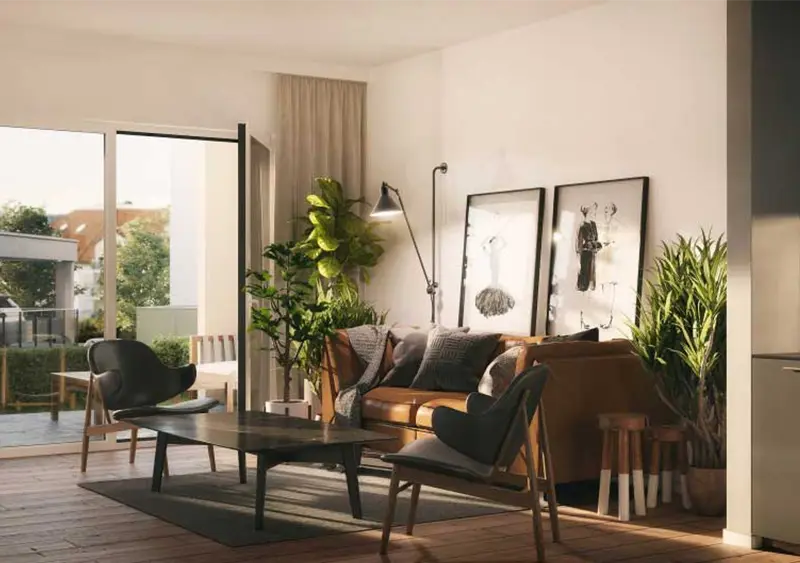Why Photorealistic 3D Rendering Is Now Essential for Interior Designers
“Good design speaks. Great rendering shouts.”

6 MIN READ
June 18, 2025

Written By
Allwyn Ruban
Introduction
Today’s clients scroll through Pinterest and Instagram, compare styles, and arrive with a clear sense of what their space should feel like. That creates pressure. Designers are expected to not only match those expectations but to sell the idea visually, before a single item is installed.
This is where the shift is happening. Designers who once relied on storytelling and swatches are now showing complete environments, lit, styled, and rendered down to the last detail. And once clients experience that level of clarity, there’s no going back.
Let’s take a closer look at what’s driving this change and why photorealistic 3D rendering is becoming essential in every modern designer’s toolkit.
The Shift in Client Expectations
Interior design used to rely heavily on trust. A designer would walk a client through plans, maybe share a few sample boards, and the rest came down to imagination. But that dynamic has changed not because designers changed, but because clients did.
People are more visually literate now. They spend hours online looking at interiors, collecting references, and refining their personal taste. By the time they speak with a designer, they already have a vision in mind. What they’re looking for is confirmation of something they can see and feel before they commit.
Mood boards and 2D drawings can start the conversation, but they often leave too much to interpretation. That’s where the tension begins. Clients ask for changes not because they don’t trust the designer, but because they can’t fully picture what’s being proposed.
Photorealistic rendering removes that gap. It gives clients the clarity they’re looking for and gives designers the confidence to present bold ideas without losing alignment.
What Makes Photorealistic Rendering So Powerful?
-
1. Realism that Builds Confidence
Good design doesn’t just look nice on paper it needs to feel right. Photorealistic rendering brings that feeling to life. It shows textures, shadows, reflections, and scale in a way that lets clients instantly understand how a space will look and function.
That level of realism creates buy-in. It removes hesitation. Clients can see exactly where their investment is going and feel more confident about saying yes to bold design choices whether it’s a dark accent wall or a custom furniture layout.
This approach isn’t just transforming interiors; it’s also revolutionizing how products are marketed online, as explored in our guide to the benefits of 3D rendering services for eCommerce.
-
2. Better Communication, Fewer Missteps
Even the most talented designers run into misalignment when visuals aren’t clear. A material might look different in person. A layout might feel tighter than expected. And revisions eat up time and budget fast.
When you present a photorealistic render, those conversations shift. Clients know exactly what to expect, and you can adjust early not after a space is built. It creates a smoother process and fewer uncomfortable surprises down the line.
-
3. Portfolio Quality That Attracts More Clients
First impressions matter, especially online. Whether it’s a website, Instagram feed, or pitch deck, high-quality visuals make a difference. Photorealistic renders help designers show their style, skill, and design sensibility with consistency.
They also fill in the gaps. Maybe a project hasn’t been built yet, or a finished space couldn’t be professionally photographed. With rendering, you don’t have to wait. You can tell your story the way you want, when you want and attract the kind of clients who resonate with your work.
From Concept to Buy-In: How Renderings Speed Up the Process
Design is creative but it’s also logistical. Timelines matter. Decisions need to be made, vendors coordinated, and budgets finalized. What slows most interior projects isn’t lack of creativity. It’s hesitation. Clients aren’t sure, so they delay. They ask for changes. And things stall.
Photorealistic renderings help break that pattern.
Instead of walking someone through a plan and asking them to imagine the result, you show them. The lighting, the colors, the proportions, it's all there. That clarity removes doubt and speeds up approvals. It also shortens the feedback loop. Clients don’t need to “think about it” for weeks when they’ve already seen it in detail.
Designers benefit too. With fewer rounds of revision, they can move into execution sooner. The pace picks up. The energy stays high. And the project keeps its momentum delivering better results through stronger, faster interior design storytelling powered by 3D rendering.
Why Outsourcing Rendering Makes More Sense Than Ever?
Not every designer wants to be a rendering expert and that’s okay. The job is already demanding: client meetings, sourcing materials, managing contractors, refining layouts. Adding high-end rendering to that list often means sacrificing time that should be spent designing.
That’s why many interior designers are choosing to outsource. It lets them focus on the creative side while still delivering visuals that meet today’s standards. No learning curves. No extra software. Just clear, client-ready visuals handled by people who do this every day.
And it’s not just about saving time. It’s about keeping quality consistent. When you work with a professional rendering team, you're not worrying about lighting settings or texture mapping. You’re sending your ideas out and getting back visuals that elevate them.
For designers juggling multiple projects or working under tight timelines, outsourcing isn’t a shortcut. It’s a smarter way to scale your impact.
Final Thoughts
Interior design has always been about more than aesthetics. It’s about trust and the ability to help clients feel at home in something that doesn’t exist yet.
That’s where 3D rendering services for interior design come into play. Photorealistic visuals bridges the gap between concept and reality, showing clients exactly what they’re saying yes to. No guesswork. No hesitation. Just clear, confident decisions backed by visuals that speak for themselves.
As expectations rise, the designers who can present with clarity are the ones who move faster, win better projects, and leave stronger impressions.
As a leading 3D rendering company from India, we work behind the scenes to help brands shine. Our photorealistic 3D renderings capture every nuance of your vision so you can walk into every presentation with clarity, confidence, and control.
About the writer :
Allwyn Ruban heads business development and marketing at Zealous Services. He’s the go-to person for finding smart ... ways to grow their 3D services, from animation to modeling. With a knack for digital strategy, Allwyn is all about helping clients achieve their goals while expanding Zealous' reach in the industry. His friendly approach makes collaboration easy and effective.
Read MoreFrequently Asked Questions (FAQ)
Do I need to know 3D software to get a photorealistic render?
No. Most interior designers collaborate with rendering studios that handle the technical side. You just provide your design brief, references, or floor plans and the studio delivers high-quality visuals based on your vision.
What makes a rendering 'photorealistic'?
Photorealistic renders simulate real-world lighting, textures, materials, and depth. They include fine details like shadows, reflections, and fabric movement, making the space look almost indistinguishable from an actual photograph.
Can I use photorealistic renders before a project is built?
Absolutely. In fact, that’s where they’re most valuable. They help clients visualize the final outcome early, which speeds up approvals and reduces the chance of design changes during execution.
How long does it take to get a rendering done?
Timelines vary based on the complexity of the space and number of views. A single-room render might take 2 to 4 working days, while full-home visuals or walkthroughs may take longer. Revisions are typically faster once the base model is set.
Why should I outsource rendering instead of hiring someone in-house?
Outsourcing gives you flexibility. You can scale up or down based on project needs without managing extra software, training, or overhead. It also lets you focus on designing, while experts handle the visual production.